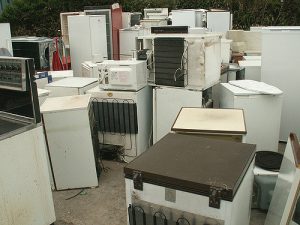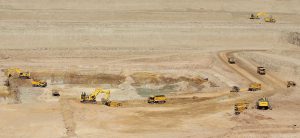China has been under international pressure in recent months following the discovery that several companies may be responsible for sustained increases in the release of CFC-11, an ozone-depleting substance that countries agreed to phase-out under the Montreal Protocol by 2010.
In an unusual move, Zeng Rong, a spokesperson for the Chinese embassy in London wrote to the Guardian newspaper on August 5 to explain just how seriously the Chinese government takes its responsibility to the international treaty. China is determined to identify and stop any illegal CFC-11 production, he said.
Investigations, so far, show that some Chinese companies chose to use banned CFC-11 in their manufacturing processes rather than adopt more expensive but less harmful alternatives. The discovery highlights the complex challenges facing the country’s environmental law enforcement, and efforts to upgrade manufacturing industries.
Delayed recovery
The ozone layer lies between 20 and 30 kilometres above the surface of the Earth and blocks harmful ultraviolet radiation. In the 1970s scientists realised that chlorofluorocarbons (CFCs), which were once widely used as a refrigerant and blowing agent for foams, were reacting with ozone in the atmosphere and damaging the thin protective shield.
To halt the damage and allow the layer to gradually recover, countries negotiated the Montreal Protocol, which set a timeline for ending the production and use of CFCs by January 2010.
Data from the United Nations Environment Programme shows that production of CFC-11 fell to almost zero by 2006. China announced that the manufacture and import of CFCs ended in July 2007 – two and a half years ahead of the Protocol timetable.
However, research published by Nature in May this year found that the reduction in atmospheric CFC-11 from 2013 onwards was 50% slower than in the previous decade. This meant almost 13,000 tonnes (± 5,000 tonnes) of CFC-11 had been released, delaying the decades-long global effort to restore the stratospheric ozone layer.
Ruling out historical stocks
So, how to explain the sudden rise in CFC-11 emissions?
A document prepared by the Montreal Protocol’s Technology and Economic Assessment Panel (TEAP) dismissed the possibility that the emissions were leaks from products and materials made with CFC-11.
In a statement it wrote: “Most of the known bank of CFC-11 is projected to be in insulating foams, particularly closed-cell polyurethane that was used in cladding panels for buildings and appliances like refrigerators.”
It added that the release of 13,000 tonnes of CFC-11 would be like disposing of 13 million large-sized refrigerators every year from 2013.
It is, therefore, unlikely that historical stocks are to blame for the rise in emissions. TEAP concluded that new and unreported manufacturing of CFC-11 is the most likely explanation but did not conclude who was responsible.
Tina Birmpili, executive secretary of UNEP’s Ozone Secretariat, called on countries to not “relax their vigilance for a second”, and for urgent measures to be taken to deal with the problem and to protect “the hard-earned reputation of the Montreal Protocol as the most successful environmental treaty”.
Is China responsible?
After publication of the research in Nature both environmental groups and media outlets stated that China was the source of the emissions.
The Environmental Investigation Agency, a UK-based non-profit, published a report on July 8 that blamed China’s rigid polyurethane foam industry for using banned CFC-11 as a blowing agent. This type of foam is commonly used as an insulator in the construction sector. The EIA said that evidence of CFC-11 was being used in China “cannot be treated as a series of isolated incidents”.
The EIA estimated that Chinese companies produced 10,307 to 12,165 tonnes of CFC-11 annually between 2012 and 2017. It also claimed that “emission estimates associated with the level of use reported by these companies can explain the majority of emissions identified in the atmospheric study”.
During the meeting of the OEWG, China’s representatives told the EIA that it was following up on the investigation’s findings but could not confirm the calculations.
In a letter to the Guardian, Chinese embassy spokesperson Zeng Rong said that Chinese law-enforcement officials had investigated 19 polyurethane manufacturers and one business cluster. One firm was found to be using CFC-11 and six investigations were ongoing. Two illegal manufacturers of CFC-11 had been identified in Henan and Liaoning provinces, in central and northeast China, respectively, with CFCs and raw materials confiscated.
Are China’s regulatory and monitoring systems ineffective? Officials from the Ministry of Ecology and Environment have denied there is a regulatory vacuum, pointing out that monitoring systems are in place to ensure control of banned chemicals. Also, in January, before the research was published in Nature, the MEE published a document emphasising strict controls on the manufacture and use of ozone-depleting substances.
Hu Min, China consultant to the Kigali Cooling Efficiency Program, said that production was a one-off incident to be considered in the context of China’s urgent need for tougher environmental law enforcement – it is not the case that China does not take global environmental issues seriously.
The struggle to raise standards
Whether or not Chinese production of CFC-11 fully explains the rise in emissions, it is clear that illegal production has taken place in China. This highlights the challenge faced by companies tasked with upgrading their production processes, and by environmental law enforcement bodies in monitoring their activities.
In recent years China’s demand for foam insulation has increased because of tougher energy efficiency regulations for new and existing buildings, and demand for cold supply chains from China’s more affluent urban middle class.
But one industry insider says alternatives to CFCs, such as new environmentally-friendly hydrofluoroolefins (HFOs), are expensive. China is still developing these chemicals and foreign multinationals have a monopoly on the supply. This is a major problem for China’s foaming agent industry, which “urgently needs to develop a proprietary environmentally-friendly foaming agent,” said the insider.
The main alternative to CFC-11 that’s currently in use is HCFC-141b. This is less damaging to the ozone layer but is still an ozone-depleting greenhouse gas. It’s listed for phase-out by the Montreal Protocol.
China has been gradually reducing the quantity of the substance used in polyurethane foam manufacturing, but the sector will have to adopt greener technology if it is to keep up with international rules.
Some manufacturers told the New York Times that limited supplies and rising prices for HCFC-141b had driven them to use CFC-11 produced by illegal manufacturers.
Hu Jianxin, a professor at Peking University’s College of Environmental Sciences and Engineering, said that failure to develop and adopt alternatives to CFCs should not be an excuse for companies to manufacture and use banned chemicals.
He added that the government should focus on controlling carbon tetrachloride, which is an essential feedstock for CFC-11. The professor also wants to see closer monitoring of the substance in the atmosphere, and assessments of China’s success in implementing the Protocol.
A meeting of signatories to the Montreal Protocol will be held in Ecuador this November. Specific measures to be taken in response to the illegal emissions of CFC-11 will be discussed then.







